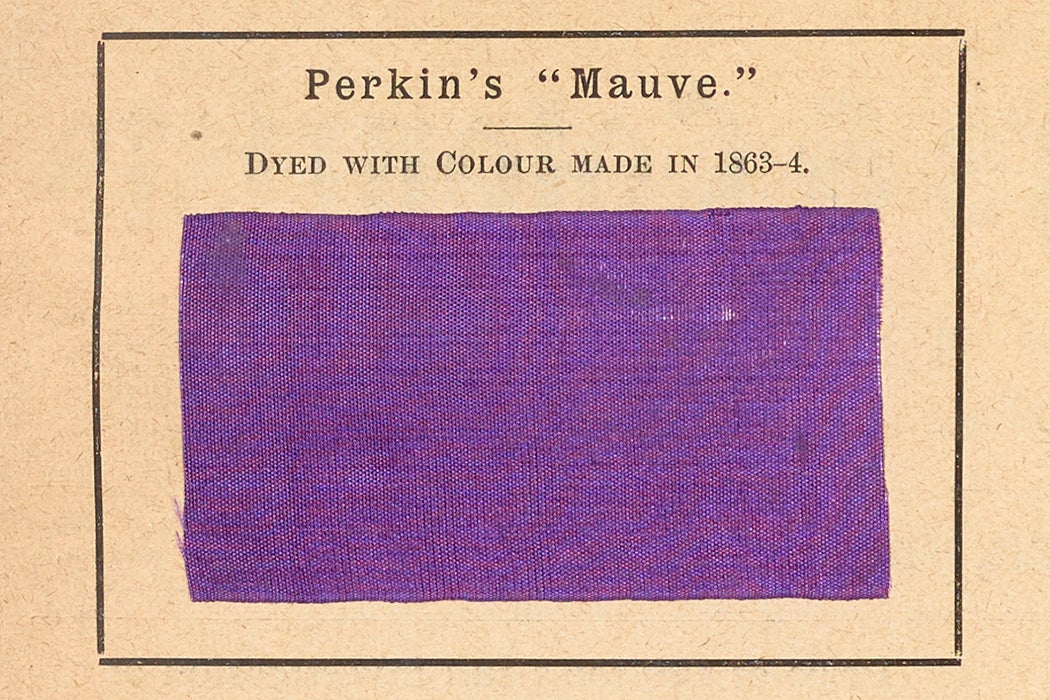In 1856, nineteen-year-old Londoner William Perkin was trying to synthesize quinine from coal tar in his home laboratory. Quinine, the only treatment for malaria, was sourced from tropical tree bark and ridiculously expensive as a result. Coal tar, on the other hand, was cheap: it was the pollution left over from coal gas, which shined light on Victorian nightlife. Typically, coal tar was dumped into the nearest river or canal. But it did have much chemical potential in its amino compounds—hence Perkin’s explorations in making an ersatz quinine. Which he failed to do.
Instead, Perkin accidentally invented the color mauve.
His purple dyestuff marked the beginning of a revolution in organic chemistry, the birth of an industry that has since given us a rainbow of colors, as well as drugs, explosives, fertilizers, plastics, and synthetics beyond measure.
Once the color of Caesar’s and Catholic cardinals’ robes, purple was long associated with royalty and being “born to the purple.” The source of this Tyrian purple was the eastern Mediterranean, where two mollusk species had been harvested for its production since the era of the Phoenicians. Making the dye was painstaking and stinky work that virtually drove the gastropods to extinction—hence the change to red robes for cardinals.
In the 1850s, purple was still a fashionable color, but the mollusks were no longer an option. The best source in the United Kingdom, then the world’s textile capital, was murexide. Although named in honor of the Murex snail, it was actually derived from guano. That’s right: bird excrement. Scholar Anthony S. Travis, in his telling of Perkin’s story, writes that murexide gave a brilliant color, but it “faded quickly in the heavily polluted, sulfurous city air.”
Perkin was the assistant to the head of the Royal College of Chemistry. In the lab he’d set up in his parents’ loft, he either intentionally or accidentally stained a piece of cloth in the brilliant purple solution he came up with after adding alcohol to the oily mess he’d created from the aniline in coal tar. He couldn’t remove it by washing. He realized this color, which “resisted the action of the atmosphere, light, and soap,” had tremendous potential.
He initially labeled it Tyrian purple, to capitalize on history. He soon switched to calling it mauve, after the French name for the mallow flower. France is where dyers and textile printers eagerly adopted his new color, driven in part by the monopoly on a lichen-derived purple that was their only other option. The fact that Perkin hadn’t been able to get a patent in France probably helped with its rapid acceptance, too.
English and Scottish dyers and printers followed the trend set by France, perhaps regretting their initial reluctance to go with the novel, home-grown color.
Weekly Newsletter
Perkin’s success and fortune (his British patents were solid) sparked a rush of explorations into aniline across Europe. Other dyes followed: “aniline red (magenta, fuchsine), aniline blue, Hofman’s violet, and a fast aniline black.”
By 1870, both Perkin’s firm and Germany’s newly formed Badische Anilin-und Soda-Fabrik (that is, BASF—still in existence) were manufacturing alizarin, a red that had previously been extracted from the plant madder. “This was the first natural product of some complexity to be synthesized,” writes Travis. The synthetic transformation of the world had begun.
Support JSTOR Daily! Join our new membership program on Patreon today.







